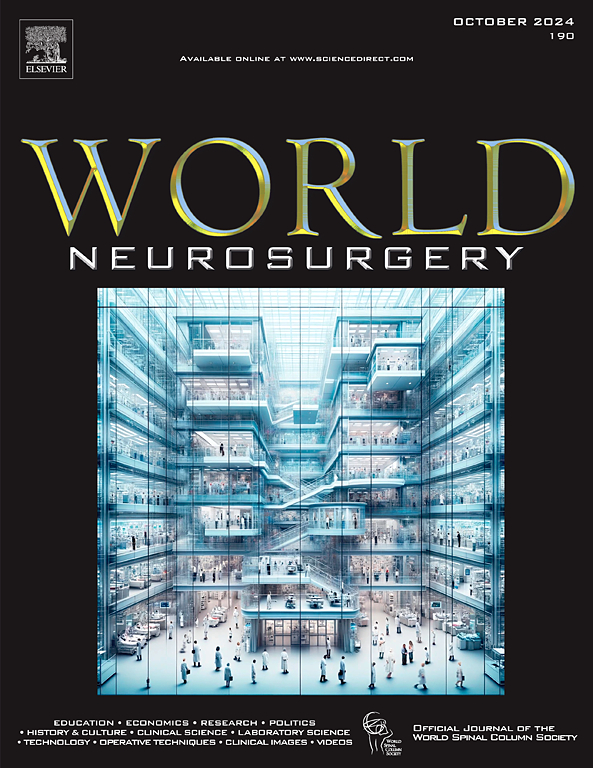Endoscope-Assisted Microsurgical Removal of Trigeminal Schwannomas
IF 1.9
4区 医学
Q3 CLINICAL NEUROLOGY
引用次数: 0
Abstract
Objective
The objective of this study was to demonstrate that trigeminal schwannomas (TSchs) located in different cranial fossae can be resected entirely through Meckel's cave which is expanded by the tumor by taking either an endoscope-assisted pterional epidural approach (EA-PEA) or an endoscope-assisted lateral suboccipital retrosigmoid approach (EA-LSRA). Additionally, we describe a modified classification based on Jefferson's system to determine the surgical approach.
Methods
This is a retrospective study of 19 patients with TSchs in different cranial fossae who underwent EA-PEA or EA-LSRA. According to the proposed system, lesions in the middle fossa are classified as type A, those in the posterior fossa are type B, and lesions in both fossae are type C, the same as in Jefferson classification. Our modifications begin by classifying lesions extending into different fossae. Those located primarily in the middle cranial fossa are denoted type C1, whereas one predominantly occupying the posterior cranial fossa is type C2. Lesions with extracranial extensions are classified as type D. Patients with type A, type C1, and type D lesions underwent EA-PEA, while those with type B and C2 lesions were treated through EA-LSRA.
Results
Thirteen patients (68.4%) underwent EA-PEA and 6 (31.6%) underwent EA-LSRA. Gross total resection was accomplished in 16 patients (84.2%). No complications were observed.
Conclusions
Our study demonstrates that EA-PEA and EA-LSRA can lead to gross total resection in patients with complex TSchs. Endoscope assistance facilitates the visualization of residual tumor. The proposed classification system is a guide for determining the surgical approach.
内镜辅助下三叉神经鞘瘤显微手术切除。
目的:本研究的目的是证明位于不同颅窝的三叉神经鞘瘤可以通过内镜辅助翼点硬膜外入路(EA-PEA)或内镜辅助外侧枕下乙状窦后入路(EA-LSRA)通过肿瘤扩张的Meckel洞完全切除。此外,我们描述了一种基于Jefferson系统的改良分类来确定手术入路。方法:对19例经EA-PEA或EA-LSRA治疗的三叉神经鞘瘤患者进行回顾性研究,将中窝病变分为a型,后窝病变为B型,两窝病变为C型,与Jefferson分类相同。我们的修改首先是对延伸到不同窝的病变进行分类。主要位于中颅窝的称为C1型,而主要位于后颅窝的称为C2型。经颅外扩展的病变分为D型。A型、C1型和D型病变行EA-PEA治疗,B型和C2型病变行EA-LSRA治疗。结果:13例(68.4%)患者行EA-PEA, 6例(31.6%)患者行EA-LSRA。16例患者(84.2%)完成全切除。无并发症发生。结论:我们的研究表明,EA-PEA和EA-LSRA可以导致复杂三叉神经鞘瘤患者的大体全切除。内窥镜辅助有助于残余肿瘤的可视化。提出的分类系统是确定手术入路的指南。
本文章由计算机程序翻译,如有差异,请以英文原文为准。
求助全文
约1分钟内获得全文
求助全文
来源期刊

World neurosurgery
CLINICAL NEUROLOGY-SURGERY
CiteScore
3.90
自引率
15.00%
发文量
1765
审稿时长
47 days
期刊介绍:
World Neurosurgery has an open access mirror journal World Neurosurgery: X, sharing the same aims and scope, editorial team, submission system and rigorous peer review.
The journal''s mission is to:
-To provide a first-class international forum and a 2-way conduit for dialogue that is relevant to neurosurgeons and providers who care for neurosurgery patients. The categories of the exchanged information include clinical and basic science, as well as global information that provide social, political, educational, economic, cultural or societal insights and knowledge that are of significance and relevance to worldwide neurosurgery patient care.
-To act as a primary intellectual catalyst for the stimulation of creativity, the creation of new knowledge, and the enhancement of quality neurosurgical care worldwide.
-To provide a forum for communication that enriches the lives of all neurosurgeons and their colleagues; and, in so doing, enriches the lives of their patients.
Topics to be addressed in World Neurosurgery include: EDUCATION, ECONOMICS, RESEARCH, POLITICS, HISTORY, CULTURE, CLINICAL SCIENCE, LABORATORY SCIENCE, TECHNOLOGY, OPERATIVE TECHNIQUES, CLINICAL IMAGES, VIDEOS
 求助内容:
求助内容: 应助结果提醒方式:
应助结果提醒方式:


